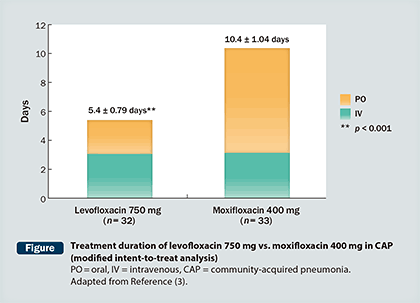Optimal Strategic Therapy for Community-Acquired Pneumonia: Levofloxacin at the Forefront of Fluoroquinolone CAP Therapy
Optimizing Therapy for Community-Acquired Pneumonia in Indonesia


Pneumonia is associated with the highest crude fatality rate (7.6%) among hospital diseases in Indonesia. To improve this situation, the practice guidelines for CAP in Indonesia were recently updated, incorporating latest global knowledge. The diagnosis of CAP is based on the presence of selected clinical features (e.g., cough, fever, sputum production, and pleuritic chest pain) and is supported by imaging of the lung, usually by chest radiography (CXR). The guidelines recommend specific diagnostic testing in patients suspected of having CAP, with outpatients requiring CXR. However, in hospitalized patients, routine laboratory hematological assessments should be added along with arterial blood gases and cultures. If drug-resistant pathogens are suspected, a sputum culture and Gram stain should be performed and, in testing for Legionella, a urinary antigen test should be done in patients with severe CAP and consideration given to bronchoscopy to identify likely pathogens.
The Indonesian Society of Respirology criteria for inpatients are a PSI score ≥ 70, although a score < 70 may underestimate the severity in younger patients (1). If these patients have a RR ≥ 30 breaths/min, PaO2/FiO2 ≤ 250 or CXR showing multilobar infiltrates with low blood pressure (SBP < 90 mmHg or DBP ≤ 60 mmHg), they should also be admitted.
Empirical antibiotic therapy is given based on the most likely pathogen, clinical trial results, and assessment of risk for resistance, with the decision to hospitalize based on prognosis, PK/PD properties, safety profile, and cost. If IV therapy is initiated, a switch to PO administration should be made as soon as the patient is hemodynamically stable and improving clinically (2). They can then be discharged when clinically stable (temperature ≤ 37.8℃, heart rate ≤ 100 beats/min, RR ≤ 24 breaths/min, SBP ≥ 90 mmHg, SaO2 ≥ 90%, with a normal mental status). Antimicrobial therapy should be continued for a minimum of 5 days, with patients afebrile for 48-72 hours, with no signs of CAP-associated clinical instability before discontinuation of therapy. A longer duration of therapy may be needed if the initial therapy is not active against an identified pathogen or if complicated by extrapulmonary infection such as meningitis or endocarditis.
These guidelines have been supported by results from an Indonesian multicenter comparative study of levofloxacin 750 mg versus moxifloxacin 400 mg, IV to PO sequential therapy once daily in patients with moderate CAP (3). The primary efficacy endpoint was the clinical success rate, defined as cure plus improvement at the third visit. The secondary efficacy endpoint included microbiological efficacy, time to switch from IV to PO therapy, safety profile, and clinical relapse rate. Levofloxacin was given IV for 2-3 days and PO for 2-3 days (5 days of treatment in total) compared with 10 days of treatment with moxifloxacin given IV for 2-3 days and PO for 7-8 days. The levofloxacin group required a significantly lower duration of treatment (5.4 days) versus moxifloxacin (10.4 days) (Figure).
 |
| Click on image to enlarge. |
Levofloxacin treatment was highly effective, with a clinical efficacy rate of 86.6%. High-dose levofloxacin was as effective as moxifloxacin (89.7%), with no statistical difference between the 2 groups, despite the moxifloxacin treatment being given for almost twice the duration.
Five patients reported adverse drug reactions (ADRs) in the levofloxacin group (15.2%) compared with 10 (26.5%) in the moxifloxacin group. The majority of ADRs were mild, with only 1 levofloxacin ADR reported as severe (3.2%) compared with 2 in the moxifloxacin arm (5.9%). Gastrointestinal disorders were the most commonly reported for moxifloxacin, followed by metabolism and nutrition disorders for both groups. In the moxifloxacin-treated group, there was 1 case of insomnia and another of nephritis, with respiratory, thoracic, and mediastinal disorders reported in 3 moxifloxacin patients and 1 levofloxacin patient.
The results presented by Dr. Priyanti confirmed that high-dose, short-course levofloxacin 750 mg is as effective and well tolerated as moxifloxacin 400 mg for moderate-to-severe CAP. It was of clinical interest that levofloxacin 750 mg achieved the same high clinical efficacy, with a significantly shorter treatment duration of 5.4 days versus the 10.4 days required for moxifloxacin 400 mg treatment. This shorter duration is likely to be associated with a reduced burden on healthcare systems and improved acceptability for CAP patients.
References
(1) Fine MJ, et al. N Engl J Med 1997; 336: 243-50.
(2) Mandell LA, et al. Clin Infect Dis 2007; 44 Suppl 2: S27-72.
(3) Nawas MA, et al. Poster No. P-N-003. 19th Congress of the Asian Pacific Society of Respirology; November 13-16, 2014; Bali, Indonesia.










